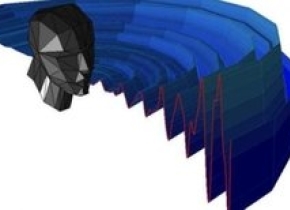

翻译:曲荟龙
审校:潘磊
People who use echolocating mouth clicks to compensate for low vision increase the number and intensity of clicks when objects are harder to detect. Christopher Intagliata reports.
来自克里斯托弗·因塔利亚塔的报道:视力障碍者会使用口部发声,回声定位方法来弥补自身缺陷,当物体难以识别时,他们常常会增加发声的次数和强度。
Many bats use a system similar to sonar to navigate in the dark. They send out high frequency sound, sometimes as clicks, and get information about their surroundings by the timing and quality of the sound that bounces back. And just as turning up the light in a darkened room helps to illuminate the objects there, bats are known to turn up the intensity of their clicks when they have trouble detecting a target.
蝙蝠能在黑暗中飞行,这是因为它们具有类似声纳的系统。他们发出高频声波,通过接收到回声的时间和强度来获取周围环境的信息。就和在黑暗的房间里你会把灯打开以照亮物体一样,当蝙蝠发现侦测目标有困难时,它们使用回声定位系统的强度就会提高。
"Now, bats have had millions of years of evolution basically to develop these mechanisms to dynamically adjust their emissions." Lore Thaler, a neuroscientist at Durham University in the U.K. "And what we were wondering is, well, do people do the same?”
“经历数百万年的进化,蝙蝠的回声定位系统已经演化到能够动态地调整声波的发射。”劳尔·塞勒是英国杜伦大学的神经学家,她表示,“我们想知道的是,人类是否会做同样的事情?”
Because some people with impaired vision can indeed navigate using the echoes of finger snaps, hand claps, or mouth clicks <<clicking sound>>. But it's not known how dynamic that ability is. So Thaler and her team presented eight expert echolocators with a challenge: could they tell whether a small dinner-plate-sized object was being held up about three feet from their head, by clicking alone?
一些视力受损的人确实会通过响指、拍手或是口哨的回声来帮助自己进行辨别方向。但截至目前,我们还不清楚他们回声定位中的声音如何变化。因此,塞勒和她的团队向八位擅长回声定位的人发起了一个挑战:他们能否仅通过回声定位这项技能,判断出一个餐盘大小的物体是否被举到自己头顶三英尺高的地方?
You can try this at home by the way, with a plate or a book. "And if you hold it very close to your face while you're speaking you can notice that the sound that you hear really changes. This is because the sound that comes out of your mouth when you speak is reflected by the object you're holding in front of you. And that's an echo.”
另外,你也可以在家里试试这个实验,你需要准备的只有一个盘子或者一本书。“把盘子或书举起,放在脸的正前方,如果距离足够近,你说话时就会发现自己听到的声音确实在发生变化。这是因为说话时,你发出的声音会被你面前的物体反弹回来。就是回声。”
But move the plate 45 degrees to the side…then 90…then behind your head. And the task gets harder. But similar to the way bats do, the study subjects increased the number of clicks, and their loudness, <<loud clicks>> as the object became harder to detect—perhaps as a way to amplify the weak sounds echoing back.
把书或餐盘移动到面前四十五度的方向,然后是九十度…接下来移到头后面。随着角度变化,实验的难度逐步增加。不过与蝙蝠的做法类似,实验者增加了回声定位的次数,还有发出声音的强度。当物体变得更加难以探测时,他们发出的声音就会变得更大,这也许为了增强微弱的回声。
The subjects still had trouble detecting the object a full 180 degrees behind them—they did only slightly better than chance. But they guessed correctly 80 percent of the time when the object was diagonally behind them. And nabbed nearly perfect scores when the disc was to the front or to the side. The results are in the Proceedings of the Royal Society B. [L. Thaler et al., Human echolocators adjust loudness and number of clicks for detection of reflectors at various azimuth angles]
尽管如此,实验者很难知道放在他们身后的物体是否发生了变化——他们的正确率只比随机猜好一点。但当物体放在他们斜后方,他们有百分之八十的比例都判断对了。而当盘子或书被放置到头的前方或侧面时,他们的回答近乎完美。这项研究的结果发表在《英国皇家学会学报B》上。[L. Thaler et al., Human echolocators adjust loudness and number of clicks for detection of reflectors at various azimuth angles]
Thaler says the study gives echolocating learners a shortcut: "If you're not sure, make a couple more clicks, and also make them louder." To produce echoes that more accurately reflect the world.
塞勒认为,这项研究为回声定位法学习者提供了一个窍门:“如果你无法确定,就多尝试几次,同时发出更强的声音。”这都是为了产生能反映世界的更为精确的回声。
 京公网安备11010502039775号
京公网安备11010502039775号